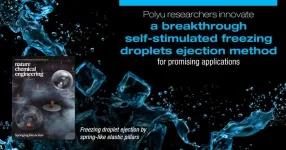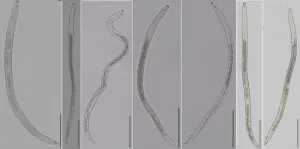(Press-News.org) Researchers find that rats create neurological maps of places to avoid after experiencing a threat and think about these locations when exhibiting worry-related behaviors. These findings—which A. David Redish of the University of Minnesota, US, and colleagues presented in the open-access journal PLOS Biology on January 14th—may provide insight into the neuroscience of common psychological conditions like anxiety.
There are many theories as to why people experience anxiety. One is that anxiety is associated with a psychological phenomenon called “approach-avoidance conflict,” where an individual desires something but is weighing that against an associated negative outcome.
To examine the neurological underpinnings of this phenomenon, researchers studied rats navigating an L-shape track. The rats would enter at one end, with food available at the opposite end of the track, but partially hidden around the corner would be a robot with claws on the front and a stinger-like tail, somewhat resembling a cross between a pincer beetle and a scorpion.
As the rats approached the food, the robot would sometimes charge forward and gnash its claws and wriggle its tail to simulate an attack. After these attacks, the rats began performing avoidant behaviors, like hesitating or fleeing back to safety, which the researchers propose are associated with worry about the robot.
Some of the rats in the experiment were implanted with probes to monitor the hippocampus, part of the brain thought to be involved in learning and memory. The researchers specifically focused on the activity of neurons called “place cells,” which activate when an animal visits a specific location. By scrutinizing their activity, the researchers could map which place cells were associated with the location of the food or of the robot.
When the rats hesitated while approaching the food, the researchers found increased activity in the place cells associated with the location of the robot and of the food. This may represent the approach-avoidance conflict between wanting the food and worry about the robot. However, when the rats turned around part-way down the track, the active place cells were mainly associated with the location of the robot.
Usually, place cells are only active when the cells’ associated location is the animal’s location or just ahead of the animal. However, as the rats turned around and fled back to the safe end of the track, their place cells associated with the distant robot remained active.
Anxiety is related to the ability to imagine situations, something the hippocampus and place cells are known to be involved in. The activity of place cells associated with negative events—especially when at a distance from their associated locations—may help scientists better understand the neuroscience of anxiety.
Underlining this association, the researchers observed far fewer worry-related behaviors among the rats when given the anti-anxiety drug diazepam, commonly known as Valium. This medication also altered the activity of the hippocampus, reducing the neural patterns associated with these anxiety-like behaviors.
The authors add, “Worrying about the future requires mental representations of imagined negative future outcomes. Rats facing a predator-like robot guarding a food source developed new mental representations of the robot’s location, resulting in rats transiently thinking about where the robot is prior to foraging for food.”
In your coverage, please use this URL to provide access to the freely available paper in PLOS Biology: http://journals.plos.org/plosbiology/article?id=10.1371/journal.pbio.3002954
Citation: Calvin OL, Erickson MT, Walters CJ, Redish AD (2025) Dorsal hippocampus represents locations to avoid as well as locations to approach during approach-avoidance conflict. PLoS Biol 23(1): e3002954. https://doi.org/10.1371/journal.pbio.3002954
Author Countries: United States
Funding: This work was funded by grants from the US National Institute of Health: R01-MH080318 (ADR), R01-MH112688 (ADR), a T32 fellowship to OLC (T32-DA037183), a T32 fellowship to CJW (T32-DA007234), summer project funding from St. Olaf College to MTE, and funding from the University of Minnesota Medical School. The funders had no role in study design, data collection, and analysis, decision to publish, or preparation of the manuscript.
END
Rats anticipate location of food-guarding robots when foraging
Specific cells in rats’ brains mark distant places to avoid after negative experiences, and rats think of these locations even after they leave
2025-01-14
ELSE PRESS RELEASES FROM THIS DATE:
The American Association for Anatomy announces their Highest Distinctions of 2025
2025-01-14
ROCKVILLE, MD—January 14, 2025—The American Association for Anatomy (AAA) is thrilled to announce the recipients of their 2025 Spring Awards. Each awardee will be formally recognized at the Anatomy Connected 2025 Closing Awards Ceremony on March 31, in Portland, Oregon.
The Spring Awards include the three highest distinctions awarded by AAA: the Henry Gray Scientific Award, the A.J. Ladman Exemplary Service Award, and the Henry Gray Distinguished Educator Award. The winners of these awards, along with the others on this list, are gathered through a nomination process conducted by their peers ...
Diving deep into dopamine
2025-01-14
Positive feedback is helpful for learning, but usually, our greatest lessons actually come from failure— and a new project at the University of Pittsburgh aims to uncover the neural mechanisms behind this phenomenon.
Helen Schwerdt, assistant professor of bioengineering at Pitt’s Swanson School of Engineering, received a five-year, $2.5 million R01 award from the National Institutes of Health (NIH) to study dopamine’s role in learning. Schwerdt’s team develops novel multimodal neural interfaces ...
Automatic speech recognition on par with humans in noisy conditions
2025-01-14
Automatic speech recognition (ASR) has made incredible advances in the past few years, especially for widely spoken languages such as English. Prior to 2020, it was typically assumed that human abilities for speech recognition far exceeded automatic systems, yet some current systems have started to match human performance. The goal in developing ASR systems has always been to lower the error rate, regardless of how people perform in the same environment. After all, not even people will recognize speech with 100% accuracy in a noisy environment.
In a new study, UZH computational linguistics specialist Eleanor Chodroff and a fellow researcher from Cambridge ...
PolyU researchers develop breakthrough method for self-stimulated ejection of freezing droplets, unlocking cost-effective applications in de-icing
2025-01-14
Water droplets under freezing conditions do not spontaneously detach from surfaces as they do at room temperature due to stronger droplet-surface interaction and lack of an energy transformation pathway. Since accumulated droplets or ice have to be removed manually or with mechanical equipment, which is costly and inefficient, preventing droplet accretion on surfaces is both scientifically intriguing and practically important. Researchers at The Hong Kong Polytechnic University (PolyU) have invented a ground-breaking self-powered mechanism of freezing droplet ejection that allows droplets to ...
85% of Mexican Americans with dementia unaware of diagnosis, outpacing overall rate
2025-01-14
More than three-quarters of older adults with dementia may be unaware of their diagnosis, a University of Michigan study finds.
That number is even higher — up to 85% — among Mexican Americans, who make up the largest share of the U.S. Hispanic and Latino population.
Fewer than 7% of all study participants, who live in Nueces County, Texas and were classified as having probable dementia based on a cognitive assessment, did not have a primary care provider.
The results are published in the Journal of General Internal Medicine.
“Dementia diagnosis unawareness is a public health issue that must be addressed,” ...
Study reveals root-lesion nematodes in maize crops - and one potential new species
2025-01-14
A new study has lifted the lid on five species of root-lesion nematodes living in maize crops across New Zealand - and suggested the existence of a hitherto-unsuspected cryptic species.
The article, ‘Molecular characterization of root-lesion nematode, (Pratylenchus spp.) and their prevalence in New Zealand maize fields’, is published in Letters in Applied Microbiology, an Applied Microbiology International publication.
Identifying these nematodes and understanding their distribution will enable targeted pest management strategies, helping to protect crop yields and maintain agricultural ...
Bioinspired weather-responsive adaptive shading
2025-01-14
Pine cones as a model: Researchers at the universities of Stuttgart and Freiburg have developed a new, energy-autonomous facade system that adapts passively to the weather. The journal Nature Communications has published the research results.
"Most attempts at weather responsiveness in architectural facades rely heavily on elaborate technical devices. Our research explores how we can harness the responsiveness of the material itself through advanced computational design and additive manufacturing," says Professor Achim Menges, head of the Institute for Computational Design and Construction ...
Researchers uncover what drives aggressive bone cancer
2025-01-14
Researchers uncover what drives aggressive bone cancer
Large-scale analysis of patient cohorts reveals a novel mechanism driving osteosarcoma, an aggressive paediatric bone cancer.
The researchers show that this mechanism occurs in approximately 50% of high-grade osteosarcoma cases.
This research also provides insights to help predict osteosarcoma patient outcomes which can help improve the management of this disease.
Osteosarcoma is a type of aggressive bone cancer that most commonly affects children and young adults between the ages of 10 and 20, during times ...
Just as Gouda: Improving the quality of cheese alternatives
2025-01-14
WASHINGTON, Jan. 14, 2025 – Plant-based dairy products are a great alternative for people who avoid animal products, but manufacturers have a hard time replicating the creamy, cheesy qualities that make dairy so indulgent.
Scientists from the University of Guelph in Ontario and Canadian Light Source Inc. in Saskatchewan are working to produce plant-based cheese with all the characteristics of real cheese, but with better health benefits.
In Physics of Fluids, by AIP Publishing, researchers studied multiple types of plant-based proteins and how they interact with ...
Digital meditation to target employee stress
2025-01-14
About The Study: The findings of this study suggest that a brief, digital mindfulness-based program is an easily accessible and scalable method for reducing perceptions of stress. Future work should seek to clarify mechanisms by which such interventions contribute to improvements in work-specific well-being.
Corresponding Author: To contact the corresponding author, Aric A. Prather, PhD, email aric.prather@ucsf.edu.
To access the embargoed study: Visit our For The Media website at this link https://media.jamanetwork.com/
(doi:10.1001/jamanetworkopen.2024.54435)
Editor’s Note: Please see ...
LAST 30 PRESS RELEASES:
Interaction of climate change and human activity and its impact on plant diversity in Qinghai-Tibet plateau
From addressing uncertainty to national strategy: an interpretation of Professor Lim Siong Guan’s views
Clinical trials on AI language model use in digestive healthcare
Scientists improve robotic visual–inertial trajectory localization accuracy using cross-modal interaction and selection techniques
Correlation between cancer cachexia and immune-related adverse events in HCC
Human adipose tissue: a new source for functional organoids
Metro lines double as freight highways during off-peak hours, Beijing study shows
Biomedical functions and applications of nanomaterials in tumor diagnosis and treatment: perspectives from ophthalmic oncology
3D imaging unveils how passivation improves perovskite solar cell performance
Enriching framework Al sites in 8-membered rings of Cu-SSZ-39 zeolite to enhance low-temperature ammonia selective catalytic reduction performance
AI-powered RNA drug development: a new frontier in therapeutics
Decoupling the HOR enhancement on PtRu: Dynamically matching interfacial water to reaction coordinates
Sulfur isn’t poisonous when it synergistically acts with phosphine in olefins hydroformylation
URI researchers uncover molecular mechanisms behind speciation in corals
Chitin based carbon aerogel offers a cleaner way to store thermal energy
Tracing hidden sources of nitrate pollution in rapidly changing rural urban landscapes
Viruses on plastic pollution may quietly accelerate the spread of antibiotic resistance
Three UH Rainbow Babies & Children’s faculty elected to prestigious American Pediatric Society
Tunnel resilience models unveiled to aid post-earthquake recovery
Satellite communication systems: the future of 5G/6G connectivity
Space computing power networks: a new frontier for satellite technologies
Experiments advance potential of protein that makes hydrogen sulfide as a therapeutic target for Alzheimer’s disease
Examining private equity’s role in fertility care
Current Molecular Pharmacology achieves a landmark: real-time CiteScore advances to 7.2
Skeletal muscle epigenetic clocks developed using postmortem tissue from an Asian population
Estimating unemployment rates with social media data
Climate policies can backfire by eroding “green” values, study finds
Too much screen time too soon? A*STAR study links infant screen exposure to brain changes and teen anxiety
Global psychiatry mourns Professor Dan Stein, visionary who transformed mental health science across Africa and beyond
KIST develops eco-friendly palladium recovery technology to safeguard resource security
[Press-News.org] Rats anticipate location of food-guarding robots when foragingSpecific cells in rats’ brains mark distant places to avoid after negative experiences, and rats think of these locations even after they leave







